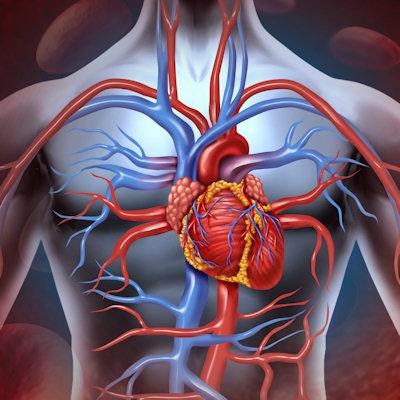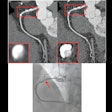
Individuals with high CT coronary artery calcium (CAC) scores -- at least 1,000 Agatston units (AU) -- had a substantially greater risk of all-cause mortality than those with lower scores and nearly triple the risk of those with a score of 0, according to research published online March 15 in JACC: Cardiovascular Imaging.
Multiple medical societies have affirmed the utility of CT CAC testing for assessing an individual's risk of heart disease and related adverse events. Most guidelines, such as those developed by the American College of Cardiology (ACC) and American Heart Association (AHA), set the threshold for the group at highest risk of a cardiac event as starting at a CAC score of either 300 AU or 400 AU.
These widely used calcium scoring specifications fall in line with the popular notion that individuals with scores exceeding 400 AU usually have denser, but not necessarily larger, calcium plaques, which are less likely to rupture. This is often the case with endurance athletes who tend to have inflated calcium scores due to the higher density of their plaques.
For the current study, senior author Dr. Michael Blaha of Johns Hopkins School of Medicine and colleagues explored potential risks associated with CT CAC scores exceeding the standard upper threshold. They obtained clinical and imaging data from the CAC Consortium cohort, which consists of 66,636 adults who underwent CT CAC exams at one of four medical centers in California, Ohio, and Minnesota from 1991 through 2010.
In contrast to the prevailing theory, the researchers found that increasing CT CAC scores -- including scores exceeding 1,000 AU -- were associated with an increasing risk of death from cardiovascular disease, congestive heart disease, cancer, and all causes, with no apparent upper threshold. For instance, the incidence rate of all-cause mortality was 9.8 per 1,000 person years for individuals with a score between 400 AU and 999 AU, and that rose to 18.8 for those with a score of at least 1,000 AU.
Furthermore, the researchers discovered that individuals with a CT CAC score of at least 1,000 AU had more than five times the risk of death from cardiovascular disease and nearly three times the risk when taking into account all causes of death, compared with those who had no indication of calcification.
| Hazard ratios for mortality risk by CT CAC score | |||
| Cause of death | CT CAC = 0 AU (reference) | CT CAC = 400-999 AU | CT CAC ≥ 1,000 AU |
| All causes | 1 | 1.98 | 2.89 |
| Cancer | 1 | 1.19 | 1.55 |
| Cardiovascular disease | 1 | 3.09 | 5.04 |
| Congestive heart disease | 1 | 3.9 | 6.79 |
The group also examined the individuals' CT scans and noted that those with a CAC score of at least 1,000 AU had a greater area of the heart exposed to calcium, denser and more dispersed calcification within the heart, and more diffuse distribution of calcification beyond the heart, compared with those with a lower score.
"Those with extensive CAC scores (CAC ≥ 1000) represent a distinct group of patients at the highest risk for all-cause mortality and cardiovascular mortality," the authors wrote. "Our analyses indicate a potential for future guidelines to recognize asymptomatic patients with extensive Agatston scores (CAC ≥ 1000) as a distinct group where targeted, more aggressive treatment should be considered."



















